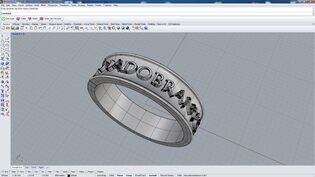|
Platinum ring with rough diamond macle and love-knot shank. This project represents a solid “voice”. You can see this and many other custom projects on my portfolio page. Many, if not most artists are encouraged to “find their voice” early in their career, especially if they begin their career in an academic venue. Finding a voice in that context usually means discovering, or adopting a recognizable style and then working exclusively within that style. This, they are told, is the road to commercial success. A rare few manage to establish themselves to the point that they can then stretch that style, or even successfully adopt another style and not lose their following or their “voice”. Picasso is a classic example of an artist that was able to transition through several styles or “periods” from his very early academic realism to what may have become his most commonly recognized style, cubism. Specializing in custom design jewelry has presented an interesting challenge with regard to finding a voice. As a custom designer my “style” has always been necessarily eclectic. One client wants something floral and busy, another wants something clean, simple and bold. Yet another wants a “futuristic” design while the next one desires something that looks antique. Finding a voice within the cacophony of client desires can be challenging indeed! And yet, I felt I had achieved a voice of sorts many years ago when clients began telling me that they could recognize one of my rings when they saw it. I like to think that within many “styles” I had achieved an elegance of execution that made my work distinctive. The feedback and success with which I was rewarded seemed to confirm that premise. Enter CAD… (Computer Aided Design) I had been fascinated by the prospect of computer design for a number of years before I actually embraced it. Finding a voice, a new voice perhaps, with a whole new approach to the design process was intimidating in many of the same ways that learning a new language can be. It is difficult for someone that is very fluid in their native language to accept the fact that for some time during the process of adapting a new language that they will communicate like a 3 yr. old…at best! And I took a road that was, in its implementation, perhaps more difficult. There are many jewelry-specific design applications that make the design process easier but may ultimately make it harder to find a voice in that they compel one to use the same pre-forms in creating a design, the same algorithms that everyone else using that application is using. For the same reason that I refused to look in jewelry store windows when I began my design career, I chose a bare-bones design application, Rhinoceros, which allowed me to find my way without necessarily walking down a well-worn jewelry path! I was lucky in that once I embrace the CAD process, I was able to integrate it into my design schedule a little at a time, using it first to make the simplest objects, ones that did not necessarily require much of a “voice”. A simple band, for example, with a phrase. A signet ring, with an established design on one surface… As time has progressed, with many more hours invested into the CAD experience I am extremely delighted to find that I am finding my voice within this new language of CAD! I dreamed this design recently and executed the design immediately after waking. It is now available on my site and is called the “Inter-dimensional Portal Key”
0 Comments
Leave a Reply. |
Author
|






 RSS Feed
RSS Feed